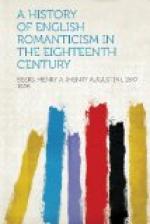As was to be expected, the zeal of the first romanticists was not always a zeal according to knowledge, and the picture of the Middle Age which they painted was more of a caricature than a portrait. A large share of medieval literature was inaccessible to the general reader. Much of it was still in manuscript. Much more of it was in old and rare printed copies, broadsides and black-letter folios, the treasure of great libraries and of jealously hoarded private collections. Much was in dialects little understood-forgotten forms of speech-Old French, Middle High German, Old Norse, medieval Latin, the ancient Erse and Cymric tongues, Anglo-Saxon. There was an almost total lack of apparatus for the study of this literature. Helps were needed in the shape of modern reprints of scarce texts, bibliographies, critical editions, translations, literary histories and manuals, glossaries of archaic words, dictionaries and grammars of obsolete languages. These were gradually supplied by working specialists in different fields of investigation. Every side of medieval life has received illustration in its turn. Works like Tyrwhitt’s edition of Chaucer (1775-78); the collections of mediaeval romances by Ellis (1805), Ritson (1802), and Weber (1810); Nares’ and Halliwell’s “Archaic Glossary” (1822-46), Carter’s “Specimens of Ancient Sculpture and Paintings” (1780-94), Scott’s “Demonology and Witchcraft” (1830), Hallam’s “Middle Ages” (1818), Meyrick’s “Ancient Armour” (1824), Lady Guest’s “Mabinogion” (1838), the publications of numberless individual scholars and of learned societies like the Camden, the Spenser, the Percy, the Chaucer, the Early English Text, the Roxburgh Club,—to mention only English examples, taken at random and separated from each other by wide intervals of time,—are instances of the labors by which mediaeval life has been made familiar to all who might choose to make acquaintance with it.
The history of romanticism, after the impulse had once been given, is little else than a record or the steps by which, one after another, new features of that vast and complicated scheme of things which we loosely call the Middle Ages were brought to light and made available as literary material. The picture was constantly having fresh details added to it, nor is there any reason to believe that it is finished yet. Some of the finest pieces of mediaeval work have only within the last few years been brought to the attention of the general reader; e.g., the charming old French story in prose and verse, “Aucassin et Nicolete,” and the fourteenth-century English poem, “The Perle.” The future holds still other phases of romanticism in reserve; the Middle Age seems likely to be as inexhaustible in novel sources of inspiration as classical antiquity has already proved to be. The past belongs to the poet no less than the present, and a great part of the literature of every generation will always be retrospective. The tastes and preferences of the individual artist will continue to find a wide field for selection in the rich quarry of Christian and feudal Europe.




